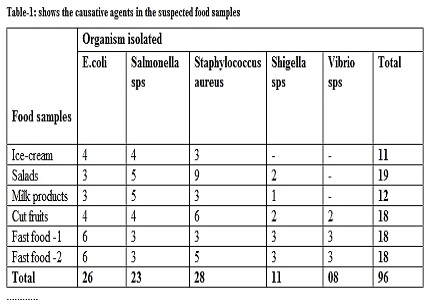Microbial profile of street food from different locations at Tumkur, India
Abstract
Introduction: The street food provided in ready –to-eat form are prepared and sold by vendors and hawkers in the street and other public places are a major source of foodborne diseases.
Aim: The present study was undertaken to detect the causative agents in street foods and to determine their antibiotic susceptibility pattern. Settings and Design: Cross-sectional study.
Materials and Methods: Food samples and Ice-creams collected from street vendors, fast food joints were homoginized, serially diluted up to 10-5 and 1ml was seeded on to Blood agar, MacConkey agar and other bacteriological media.
Results: Eighty Percentages of samples had pathogens. Salads were highly contaminated in 19 food outlets, followed by cut fruits, fast food -1(pani-puri, bhel-puri, masala puri ), fast food -2( noodles, fried rice, lemon rice).. The antibiotic sensitivity pattern revealed Staphylococcus aureus (27.08%) were resistant to ampicillin gentamicin (23.95%), ciprofloxacin (18.75%). Escherichia coli were resistant to ampicillin, ciporofloxacin. Salmonella sps isolated were resistant to ampicilin, gentamicin (20.88%), ciprofloxacin, amikacin and co-trimoxazole(13.54%). The resistance exhibited by Shigella sps were only (2.08%). Vibrio sps showed resistance to ampicillin, gentamicin, ciprofloxacin, amikacin and co-trimoxazole
Discussion: Salads had the highest number of pathogens (19.79%) followed by cut fruits, fast food-1 and 2. Staphylococcus aureus (7.26%), E.coli and Salmonella sps (5.20%) respectively were isolated. High counts of Staphylococcus aureus could be due to poor personal hygiene of the food handlers and lack of heat processing steps during preparation.
Conclusion: Education of the public and eating establishments is crucial to the control of food borne illness.
Downloads
References
2. Zeru K, Kumie A. Sanitary Conditions of food establishments in Melella Towm, Tigary, North Ethiopia. Ethiop.J.Health Dev 2002; 21(1):3-11.
3. Zige DV, Ohimain EI, Sridhar KC. Enteric Bacteria from ready to eat food vended in Amassoma community in Niger Delta and its health implication. IOSR Journal of Environmental Science, Toxicology And Food Technology (IOSR-JESTFT).2013; 6(4):62-5.
4. Nurudeen AA, Lawal AO, Ajayi SA. A survey of hygiene and sanitary practices of street food vendors in the Central State of Northern Nigeria. Journal of Public Health and Epidemiology. 2014 May 19;6(5):174-81.
5. Codex Alimentarius Commission. Revised Regional Guidelines for the Design of Control Measures for Street-Vended Foods in Africa. CAC/GL-22-Rev. 1; 1999.
6. Gawande HA, Mishra AA, Shukla RN, Jain J. Socio-economic profile of street food vendors and quality evaluation of Samosa and Panipuri in Allahabad City (UP), India. International Journal of Agriculture and Food Science Technology 2013; 4(3):275-80.
7. Janie P, Marie T. Street food in Kolkata-A hygienic perspective Project in practice 400040.
8. Tambekar DH, Kulkarni BV, Shirsat SD, Bhadange DG. Bacteriological Quality of Street vended food Panipuri: A case study of Amarvathi city (MS) India. Bioscience Discovery 2011; 2(3):350-54.
9. Collee JG, DuguidJP, Fraser AG, Marmion BP, Simmons A. 1996. Mackie and McCartney Practical Medical Microbiology. 14th Edn. New Delhi. Harcourt Brace and Company limited.2006.
10. Collins CH, Patricia M L, Grange JM. . Microbiology Methods 7th Edn. London. Butterworth &Co (Publishers) Ltd. 1995.
11. Clinical Laboratory Standards Institute. Performance Standards for Antimicrobial Testing: Twentyfifth Informational Supplement CLSI document M100-S17;2015.
12. Madueke SN, Awe S, Jonah AI. Microbiological analysis of street foods along Lokoja-Abuja express way, Lokoja. American Journal of Research Communication. 2014; 2(1):196-211.
13. Tuladhar R, Singh A. Bacterial Analysis and Survey of the Street Food of Kathmandu in Relation to Child Health. Journal of Natural History Museum. 2015 Dec 17; 26(1):1-9.
14. Mensah P, Yeboah-Manu D, Owusu-Darko K, Ablordey A. Street foods in Accra, Ghana: how safe are they? Bull World Health Organ. 2002;80(7):546-54. Epub 2002 Jul 30. [PubMed]
15. Derbew G, Sahle S, Endris M. Bacteriological assessment of some street vended foods in Gondar, Ethiopia. Internet J Food Safety. 2013; 15:33-8.
16. Poojara RH, Krishna G. Microbiological profile of street vended foods in Cochin, Kerala India. Biosci. Discov. 2012;3(2):179-85.Mathur P, Reddy V. Bacterial contamination of infant foods. IJMR1983; 77:342-6.
17. Mathur R, Reddy V. Bacterial contamination of infant foods. Indian J Med Res. 1983 Mar;77:342-6. [PubMed]
18. Głośnicka R, Kunikowska D. The epidemiological situation of Salmonella enteritidis in Poland. International journal of food microbiology. 1994 Jan 1; 21(1-2):21-30.
19. Chauhan N, Uniyal V, Rawat DS. Microbial profile of street foods in different locations at Dehradun city,India. J. Biol. Agri. Health. 2015; 4(1);340-7.



 OAI - Open Archives Initiative
OAI - Open Archives Initiative


